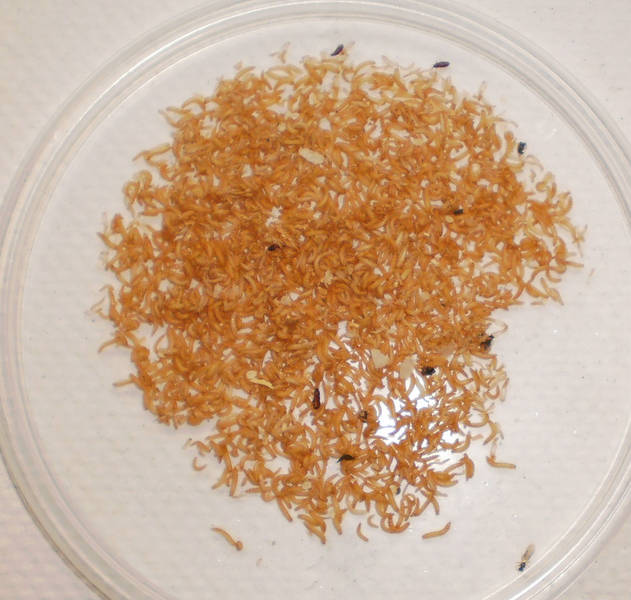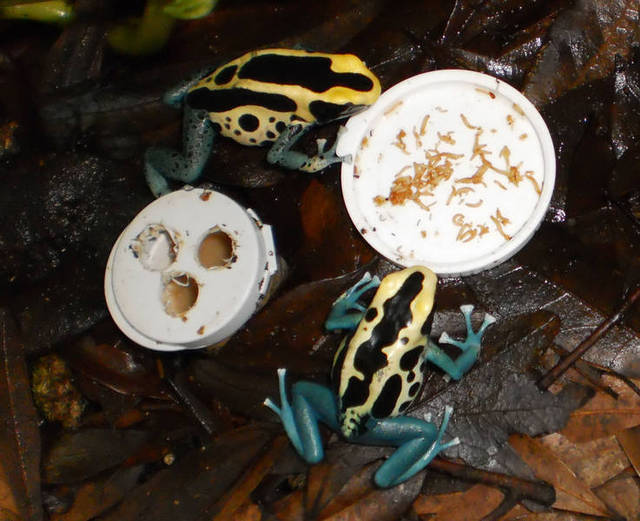I've seen many posts where people say flour beetles aren't worth the trouble.
I thought I'd share this method and some tips to make things easier. This is basically just a cut and paste from my blog on my website.
![Click the image to open in full size.]()
Flour Beetle larvae make a good occasional feeder for our frogs.
Most frogs don't really like the adult beetles, because they produce a quinone gas that apparently doesn't taste too great. I've seen frogs do back flips and tounge dragging when they try their first flour beetle.
Adult beetles can live 3 years and produce a thousand offspring. The entire life cycle, egg to adult is about 5-6 weeks at 77°F, cultures produce faster at temps up to 90°F. A week or two after starting a new culture, just sift out the adults for another culture. It usually takes about 4 weeks to get good size worms for feeding out.
![Click the image to open in full size.]()
Culture media is whole wheat flour and 10% Brewers Yeast. Flour beetles produce best on ~12% protein media. Adults and larvae will feed on eggs if the protein level is too low. Keep your cultures dry and well ventilated. They can't climb glass or smooth plastic, but the adults can fly a short distance if they can get on top of something to leap off.
![Click the image to open in full size.]()
1 pound of media can produce 1500 larvae. It is best to sift your cultures every week to keep from having too many pupate and turn into more beetles. After a few weeks you can add adults again and a little fresh media to restart your culture.
I keep 4 shoebox size cultures going at a time, the first one has beetles laying eggs, the second one the larvae are too small to feed, third and forth get fed out.
![Click the image to open in full size.]()
I used to use a small sifter like this, which is fine for a couple small cultures; but took way too long for several shoe box size cultures. The mesh size you want is about 20 - 24 wires per inch, which is much finer than standard window screen.
![Click the image to open in full size.]()
Most whole wheat flour has a lot of wheat bran in it that won't pass thru the sifter. This is the only brand of whole wheat flour I have found that is ground ultra fine. It does not need to be pre-sifted. All the other brands must be sifted to remove all the bran and other large particles of wheat. If you skip this step you will be very frustrated when you try to separate the larvae or beetles from the media.
![Click the image to open in full size.]()
These larvae are ready to fed out and can be dusted with supplements if desired. I don't have the actual analysis but I believe they are about 45% protein and 35% fat.
I only feed out about once a week, they are too fatty for continuous feeding, but can help to put weight on skinny frogs. There will be some dry larvae skin sheds and sometimes a little frass mixed in with the larvae. I usually take the sifted worms outside and blow this away with a couple light puffs of air.
![Click the image to open in full size.]()
If you get a lot of adults mixed in with the larvae, you can drape some paper strips over the edge of your worm cup into a larger container to allow the beetles to climb out.
![Click the image to open in full size.]()
The frogs won't really know what to make of them the first time you feed them out. I've seen some frogs spit them out the first few tries. But once they're use to them, they'll usually come running when you place a lid in their tank.
Larvae don't do well in high humidity or if they get wet. Any that get out of the lid will perish in our vivs if they don't get eaten with a few hours.
Here is a good study on different medias that were tried.
http://www.researchgate.net/publicat...a006b4f23f.pdf
I thought I'd share this method and some tips to make things easier. This is basically just a cut and paste from my blog on my website.
Flour Beetle larvae make a good occasional feeder for our frogs.
Most frogs don't really like the adult beetles, because they produce a quinone gas that apparently doesn't taste too great. I've seen frogs do back flips and tounge dragging when they try their first flour beetle.
Adult beetles can live 3 years and produce a thousand offspring. The entire life cycle, egg to adult is about 5-6 weeks at 77°F, cultures produce faster at temps up to 90°F. A week or two after starting a new culture, just sift out the adults for another culture. It usually takes about 4 weeks to get good size worms for feeding out.

Culture media is whole wheat flour and 10% Brewers Yeast. Flour beetles produce best on ~12% protein media. Adults and larvae will feed on eggs if the protein level is too low. Keep your cultures dry and well ventilated. They can't climb glass or smooth plastic, but the adults can fly a short distance if they can get on top of something to leap off.
1 pound of media can produce 1500 larvae. It is best to sift your cultures every week to keep from having too many pupate and turn into more beetles. After a few weeks you can add adults again and a little fresh media to restart your culture.
I keep 4 shoebox size cultures going at a time, the first one has beetles laying eggs, the second one the larvae are too small to feed, third and forth get fed out.

I used to use a small sifter like this, which is fine for a couple small cultures; but took way too long for several shoe box size cultures. The mesh size you want is about 20 - 24 wires per inch, which is much finer than standard window screen.

Most whole wheat flour has a lot of wheat bran in it that won't pass thru the sifter. This is the only brand of whole wheat flour I have found that is ground ultra fine. It does not need to be pre-sifted. All the other brands must be sifted to remove all the bran and other large particles of wheat. If you skip this step you will be very frustrated when you try to separate the larvae or beetles from the media.

These larvae are ready to fed out and can be dusted with supplements if desired. I don't have the actual analysis but I believe they are about 45% protein and 35% fat.
I only feed out about once a week, they are too fatty for continuous feeding, but can help to put weight on skinny frogs. There will be some dry larvae skin sheds and sometimes a little frass mixed in with the larvae. I usually take the sifted worms outside and blow this away with a couple light puffs of air.

If you get a lot of adults mixed in with the larvae, you can drape some paper strips over the edge of your worm cup into a larger container to allow the beetles to climb out.

The frogs won't really know what to make of them the first time you feed them out. I've seen some frogs spit them out the first few tries. But once they're use to them, they'll usually come running when you place a lid in their tank.
Larvae don't do well in high humidity or if they get wet. Any that get out of the lid will perish in our vivs if they don't get eaten with a few hours.
Here is a good study on different medias that were tried.
http://www.researchgate.net/publicat...a006b4f23f.pdf